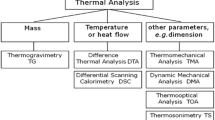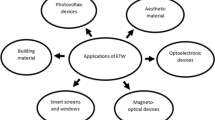Summary
The aim of this study was to investigate the influence of the orientation and the structure of wood on drying with radio-frequency. The determination of the dielectric properties of wood types by measuring the dielectric constants and the loss angle gives reliable results for wood with about 0...20% moisture content. A method was therefore developed which makes it possible to calculate the heating rate of specimens of any desired initial moisture content by determining the temperature, the weight loss and the internal steam pressure.
By comparing the heating rates of the various specimen, some rules governing the behaviour of the wood in a radio-frequency field could be ascertained. A distinction was made between kiln-dried and humide wood, and between the heating and the drying period.
Similar content being viewed by others
Schrifttum
Benson, H. P.: Variation in the Porosity of Twelve Species of Oak, South. Lumb. Reprint March 15, 1942.
Birjukov, W. A.: Holzkammertrocknung im elektrischen Hochfrequenzfeld, Verlag Goslesbumizdat 1950.
Buchmann, S. J., H. Schmitz, u. R. A. Gortner: A Study of Certain Factors Influencing the Movement of Liquide in Wood, J. Physic. Chem. Bd.39 (1935), S. 102.
Burr, H. K., u. A. D. Stamm: Diffusion in Wood. J. Physic. Colloid Chem. Bd.51 (1947) S. 240/261.
Dänzer, H.: Über das Verhalten biologischer Körper im Hochfrequenzfeld. Ann. d. Physik 5. Folge Bd.20 (1934) S. 463/480.
Ebes, K.: Vorming van Thyllen in Geveld Benkenhout, Diss. Wageningen 1937.
Fessel, F.: Hochfrequenztrocknung von Laubhölzern. Versuchsergebnisse. Holz als Roh- und Werkstoff Bd.10 (1952) H. 6, S. 280/283.
Fessel, K.: Die praktische Durchführung der Holztrocknung im hochfrequenten elektrischen Kondensatorfeld in verschiedenen Ländern. Holz als Roh- und Werkstoff Bd.14 (1956), H. 2, S. 41/47.
Frey-Wyssling, A.: The Fine Structure of Cellulose Microfibrils. Science Bd.119 (1954) S. 80/82.
Frey-Wyssling, A.: On the Crystal Structure of Cellulose I. Biochim. Biophysica Acta Bd.18 (1955) S. 166/168.
Hafner, Th.: Energiebedarf bei der Hochfrequenzerwärmung von nichtleitenden Stoffen. Brown Boveri Mitt. Bd.28 (1951) S. 344/345.
Hamada, R., R. Maku, u. S. Kadita: Wood Drying by Radio-Heating. Bull. Wood Res. Inst. Kyoto Univers. Bd.8 (1952), S. 44/54.
Hartmann-Dick: Untersuchungen über die Durchlässigkeit des holzes bei Druckfiltration. I. Durchlässigkeit für Wasser. Forstwiss. zbl. Jg.73 (1954) H. 1/2, S. 40/63.
Hearmon, R. F. S.: The High-Frequency Eleetrical Properties of Wood and Wood-Resin Combinations. Selected Government Res. Rep. Bd.8 (1952) S. 52/60.
Hearmon, R. F. S., u. I. N. Burcham: The Dielectric Properties of Wood. For. Prod. Res. London 1954, Nr. 8, S. 1/19.
Huber, B.: Die physiologische Bedentung der Ring- und Zerstreutporigkeit Sonderabdr. aus: Ber. Dtsch. Bot. Ges. Bd.53 (1935) H. 8.
Inose, O., u. O. Takechi: Analysis on the Fundamental Properties of Electric Resistance of Wood. Scient. Rep. Matsuyama Agric. College 1951 Nr. 6, S. 1/22.
Ishag, S. M.: High-Frequency Drying of Wood, For Prod. Labor. Rep. Nr R 1681 Madison/Wiscousin (1947).
Keylwerth, R., u. D. Noack: Über den Einfluß höherer Temperaturen auf die elektrische Holzfeuchtigkeitsmessung nach dem Widerstandsprinzip. Holz als Roh- und Werkstoff Bd.14 (1956) H. 5, S. 162/172.
Kirch, E.: Verluste in technischen Isolierstoffen. E. Z. 1932 H. 39, S. 931/932; H. 40. S. 958/961; H. 42, S. 1007/1010 u. 1021/1022.
Koljo, B.: Über die Mechanik der Flüssigkeitsbewegung bei der Holzimprägnierung. Svenska Träforskningsinst. Mitt. 25B, (1951).
Koljo, B.: Die Abhängigkeit der Tränkmittelaufnahme des Holzes von verschiedenen Faktoren unter besondererBBerücksichtigung von Kiefer und Fichte. Holz als Roh- und Werksstoff Bd.11 (1953) H. 8, S. 303/311.
Kollmann, E.: Untersuchungen über die Ursachen von Schänden bei der Trockmung von grünem Eichenholz Zugleich: Mitt. über Festigkeitsprüfungen an Holz im hochfrequenten Wechselfeld. Svenska Trädorskningsinst. Mitt. 21 (1950).
Kollmann, F.: Technologie des Holzes und der Holzwerkstoffe. 2. Aufl. 1. Bd., Berlin. Göttingen Heidelberg: Springer 1951.
Kröll, K.: Die Bewegung der Feuchtigkeit im Nadelholz während der Trocknung bei Temperaturen um 100°. Holz als Roh- und Werkstoff Bd. 9 (1951) S. 176/181 u. S. 216/224.
Kröner, K.: Über die dielektrischen Untersuchungen an Naturhölzern und deren mechanische und chemische Abauprodukte im großen Frequenzberich. Diss. Braunschweig 1943.
Kröner, K., u. L. Pungs: Über das Verhalten des dielektrischen Verlustfaktors von Naturholz im großen Frequenzbereich. Abh. Braunschweig. Wiss. Ges. Bd. IV (1952).
Kröner, K., u. L. Pungs: Zur dielektrischen Anisotropie des Naturholzes im großen Frequenzhberich. Holzforsch. Bd. 6 (1952) S. 13/16.
Krpan, T.: Untersuchungen über den Fasersättingungpunkt des Buchen-, Eichen-, Tannen-, und Fichtenholzes. Holz als Roh- und Werkstoff Bd. 12 (1954), S. 84/91.
Kühne, H., R. C. Bremer u. Th. Hafner: Hochfrequenz-Holztrocknung, Neue Züricher Ztg. “Beilage Technik” Nr. 767, März 1954.
Kühne, H., u. J. Vodoz: Untersuchungen über das Schwinden und Quellen einiger schweizerischer Hölzer. Eidg. Materialprüfungsanstalt Zürich, Ber 179, Dez. 1951.
Kühne, H., H. Fischer, u. J. Vodoz: über den Einfluß von Wassergehalt, Raumgewicht, Faserstellung und Jahrringstellung auf die Festigkeit und Verformabarkeit schweizerischen Fichten-, Tamen-, Lärchen-, Rotbuchen- und Eichenholzes. Eidg. Materialprüfungs- u. Versuchsanstalt, Zürich, Ber. 183, 1955.
Lindmann, K. F.: Über die Doppelbrechung elektrischer Wellen in Eichenholz. Z. techn. Physik, Bd. 20 (1939), Nr. 3, S. 72/75.
Myer, J. E., u, L. W. Rees: Electrical Resistance of Wood with Special Reference to the Fiber Saturation Point. Techn. Bull. Univers. of Syracuse N. Y. Vol. 26 (1926), Nr. 19, S. 1/22.
Nakato, K., u. S. Kadita: On the Dielectric Properties of Wood in Relation to the Moisture Content and the Temperature. Meet. Jap. For. Soc. Trans. Vol. 63 (1954), S. 271/272.
Nakato, K., u. S. Kadita: On the Dielectric Constant of Ovendried Wood. J. Japanese For. Soc. Bd 36 (1954), No. 4, S. 95/100.
Narayanamurti, D.: The Variation of the Electrical Resistance of Indian Timbers with Moisture Content. For. Res. Ist. Dehra Dun Bull. No. 105 (1941).
Narayanamurti, D., u. A. Purushotham: Studies in Permeability, Part. I. A. Preliminary Note on the Permeability of Wood and Other Materials to Air. For, Res. Inst. Dehra Dun. Bull. No. 120 (1943).
Naravanamurti, D., V. Ranganathan u. R. S. Ratra: Bewegung von Flüssigkeiten durch Holz. Holz als Roh- und Werkstoff Bd. 9 (1951) H. 11, S. 422/426.
Peterson, R. W.: The Dielectric Properties of Wood. For. Prod. Lab. Canada Mimeograph o. 151 (1953).
Pratt, D. H., u. A. R. Dean: Report on an Investigation into the Drying of Timber by the Application of Radio Frequency Heating. For. Prod. Res. Lab. Princes Risborough Aylesbury, Bucks (Okt. 1951).
Pungs, L.: Holz als Dielektrikum im Hochfrequenzfeld. ETZ, A, Bd. 75 (1954), S. 433/438.
Shinohara, U., S. Otori u. K. Iwata: On the Drying Mechanism of Radio-Frequency Heating. Mem. Fac. Eng., Nagoya Univer. Bd. 4 (1952), No. 1, S. 1/47.
Skaar, Ch.: The Dielectrical Properities of Wood at Several Radio Frequencies. New York State College of Forestry at Syracuse University, Techn. Pub. No. 69 (1948).
Stamm, A. J.: Passage of Liquide, Vapors and Dissolved Materials Through Softwoods. Fro. Prod. Lab. Madison, Techn. Bull. No. 929 (1946).
Takechi, O., u. O. Inose: On the Electric Resistance of Wood in Relation to the Moisture Content and the Temperature. Scient. Rep. Matsyama Agric. Coll. Jg. 1953 No. 10, S. 13/25.
Trapp, W.: Das dielektrische Verhalten von Holz und Zellulose im großen Frequenz- und Temperaturbereich. Diss. Braunschweig 1945.
Trendelenburg, R., u. H. Mayer-Wegelin: Das Holz als Rohstoff. 2. Aufl. München: Carl Hanser Verlag 1955.
Tsuneo, N.: Study on the Electrical Resistance of Todo fir. Meet. Jap. For. Soc. Trans. Bd. 59 (1951), S. 228/231.
Villière, A.: Le Séchage des Bois par courants Haute Fréquence. Rev. Bois, Bd. 11 (1956), S. 26/31.
Vodoz, J.: Le Retrait et le Gonflement du Bois. J. For. Suisse, Jg. 1953, Nr. 10, S. 1/10.
Vodoz, J.: Eine neue Versuchsanlage zur Prüfung des Verhaltens der verschiedenen Holzarten bei der Hochfrequenz-Trocknung. Holz als Roh- und Werkstoff Bd. 14 (1956), S. 407/409.
Wittkopf, J. J., u. M. D. Mac Donald: Dielectric properties of Douglas fir at High Frequencies. Oregon State College, Corvallis, Bull. No. 28. (1949).
Wittkopf, J. J., u. M. D. Mac Donald: Dielectric Properties of Ponderosa Pine at High Frequencies. Oregon State College, Corvallis Bulletin No. 29 (1949).
Yavorsky, J. M.: A Review of Electrical Properties of Wood. State University of New York College of Forestry, Syracuse. Techn. Publ. No. 73.
Anonymus: Special Methods of Seasoning Wood: High-Frequency Dielectric Heating. For. Prod. Lab. Madison 5, Wisc. Report No. R 1665-7 (1948).
Author information
Authors and Affiliations
Rights and permissions
About this article
Cite this article
Vodoz, J. Das Verhalten des Holzes während der Trocknung im hochfrequenten Wechselfeld. Holz als Roh-und Werkstoff 15, 327–340 (1957). https://doi.org/10.1007/BF02611305
Issue Date:
DOI: https://doi.org/10.1007/BF02611305




